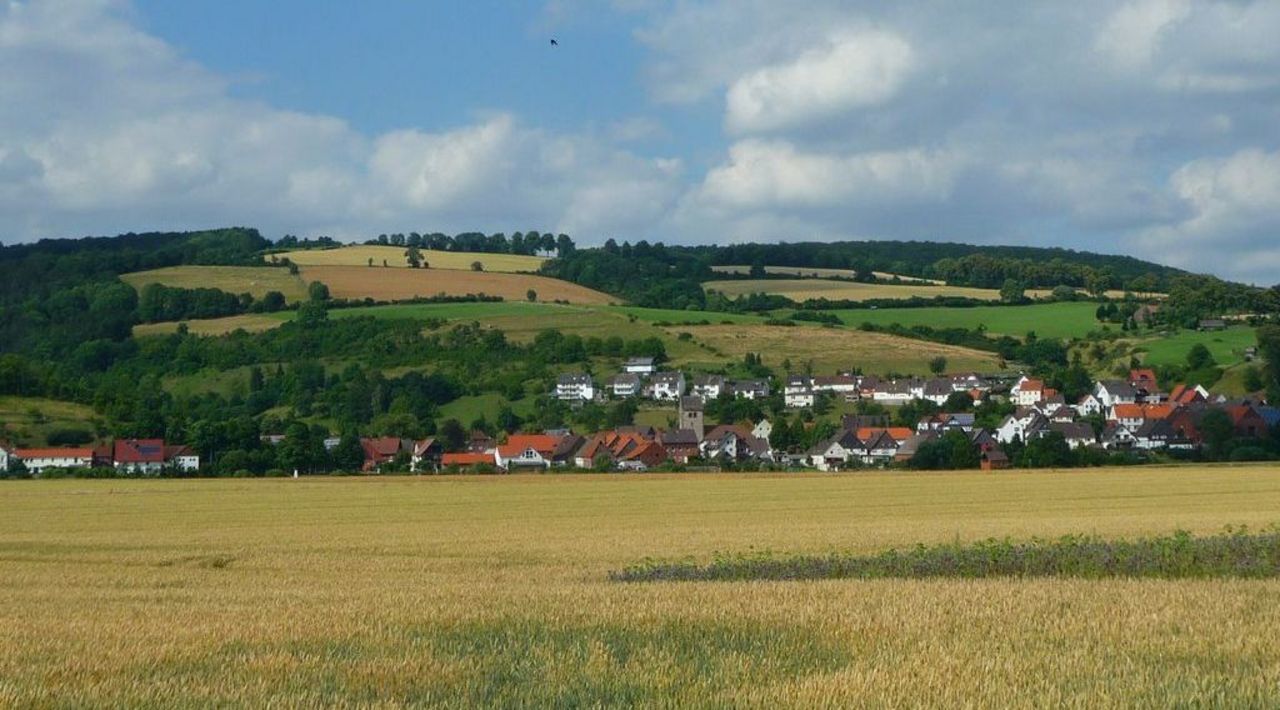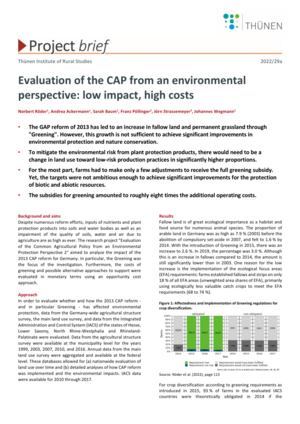Project
Environmental impacts of the 2013 reform of the common agricultural policy (GAPEval II)

Evaluation of the CAP reform of 2013 from the point of view of environmental protection by means of a database analysis of IACS data of the federal states (GAPEval II)
The EU Commission decided in 2013/2014 to reform the Common Agricultural Policy (CAP). The aim is a better distribution of the agricultural funds and a more environmentally friendly, „greener“, first pillar of the CAP. The reasons for the reform were the observation of dramatic declines in number of species in the agricultural landscape and persistently high inputs of nutrients and plant protection products (PPPs) into the soil and water. In addition, in regions with intensively used agricultural land, voluntary agri-environmental measures have rarely been implemented. The aim of this research project (GAPEVAL II) was to assess the impact of the CAP reform on the abiotic resource protection in Germany, based on the data from the Integrated Accounting and Control System (IACS). An additional goal was to develop alternative proposals for changes to achieve the objectives. The project based, inter alia, on the findings of the previous GAPEval project.
Background and Objective
From 2014 to 2020 approximately one-third of the total budget of the EU was spent on the CAP. Germany is the largest contributor to the overall EU budget. Therefore it has a great interest in ensuring that the public funds are used effectively and efficiently. In Germany, agriculture is by far the largest land user, with a large number of positive and negative environmental impacts on soil, water, air, climate and biodiversity.
At the time of the project start the future of the CAP after 2020 was under discussion. But so far there was little empirical evidence on the impact of the CAP reform 2013 on environmental goods. Several reasons were recognized for this, of which only a few will be mentioned. The Greening was not introduced until 2015. As a result, it became clear to farmers only at the beginning of 2015 what specific conditions they would have to fulfil. In addition, national agri-environmental programs were newly launched in 2015. In summary, 2015 is seen as an adaption year. After the introduction, farmers first had to gather experience on how to implement these new instruments in the most sensible way. It could therefore be assumed that some effects will only occur after several years. This was analyzed in the follow-up project GAPEval II.
The research project had the following objectives:
The environmentally relevant effects of the CAP reform were to be examined on the basis of an environmental indicator set. The focus was on the effectiveness and efficiency of the funds used. In addition, a spatially differentiated analysis of the implementation of area-related EAFRD measures was carried out (EAFRD: European Agricultural Fund for Rural Development). Furthermore, the costs of the individual greening measures were estimated at the farm level. Finally, concrete and practicable proposals were developed at the level of instruments and measures to increase the desired environmental impacts.
Target Group
Ministries of agriculture and environment, farmers, consultants, official nature conservation, agricultural administration, European Commission
Approach
First, the IACS data were examined with regard to the following aspects:
- The establishment of ecological focus areas
- The implementation of grassland protection
- The differentiation of cultivated plants
- Other abiotic environmental issues
Second, the costs of greening were estimated by evaluating the 2016 agricultural structure survey and by an economic analysis of the greening measures. Finally, the results of the analysis were evaluated and interpreted to derive recommendations for actions.
Additionally the Julius Kuehn Institute for Strategies and Impact Assessment carried out a regionalized assessment of the environmental risk of pesticide use.
Data and Methods
IACS data from various federal states from 2010 to 2018 are used. This project is based on the already completed projects on greening (LINK ZUM DACHPROJEKT). The focus of the analysis is on the development of permanent grassland, the implementation of ecological focus areas and crop species diversity. The latter is not only investigated at the farm level, but also at the landscape level, since the increase in the average farm size is expected to lead to an increase in crop species per farm. Furthermore, the data will be analyzed with regard to the development of four further aspects: the farm size, location and relation of the fields as well as the farms to each other, the water erosion potential, the humus balance and the use of environmentally sensitive sites.
In order to prepare a well-founded analysis of the aspects listed in addition to the greening measures, the agri-environmental and climate measures of the federal states are also taken into account.
Our Research Questions
Establishment of Ecological Focus Areas
- What contribution do the implemented options of Ecological Focus Areas make with regard to questions such as of erosion control, change in the humus balance and discharge risk for nutrients and pesticides?
Implementation of grassland protection
- How much land is lost as a result of conversion to other agricultural uses?
What role does the non-application for conversion of grassland registered under IACS play and how much land is transformed to non-agricultural forms?
- What differences are recognizable at the level of soil climate zones, protected areas, different location parameters and farm types?
- What developments can be observed over time (intensity of use, grassland area)?
Crop species differentiation
- Did cultural diversity change at the regional and local level?
- Are there permanent changes in the scope of cultivation of certain crops?
- Are there any changes in crop rotations?
Other abiotic environmental issues
- What are the sizes and locations of the individual fields of a farm as a whole and in relation to each other?
- How high is the water erosion potential or the erosion risk of the areas?
- Flooding areas: How high is the risk, or rather what would be the effects of the direct input of agricultural inputs into aquatic ecosystems?
- How high are the humus contents of the soils?
- How is land use developing in environmentally sensitive locations? (organic soils or floodplains? )
Estimation of the costs of greening
- How high are the individual adaption costs for the greening?
- To what extent do farmers accept reductions in greening payments?
- How should the greening measures be designed so that the implementation of measures with a high environmental effect becomes more attractive for the farms? What impact would it have if farms would increasingly implement measures with a high environmental impact?
- Are the subsidies for greening measures and instruments used efficiently?
How can the efficiency of greening be improved?
Results
The 2013 GAP reform led to minor improvements for environmental protection and nature conservation. The amount of ecologically valuable land was minimally increased compared to 2010, although the level of the early 2000s was not reached. Also, little positive changes were observed in the diversity of arable crops and the use of plant protection products as a result of greening. The design of the Greening components was not ambitious enough to bring about significant positive environmental effects.
Against the background of the various strategic plans of the EU, the results of the study serve as a basis for a national design of the GAP from the point of view of environmental protection. One of the goals of the farm-to-fork strategy, a halving of the use and risk of chemical pesticides, should not only be considered against the background of the quantity applied and its toxicity, but the hazard potential should also be differentiated according to land use. This is shown by the analysis on the environmental risk of plant protection products. With regard to the "Biodiversity Strategy for 2030", which also aims to reduce the damaging effects of plant protection products, synergy effects arise here.
A brief summary of the core findings can be found in the Project Brief.
Links and Downloads
Thünen-Contact

Involved Thünen-Partners
Involved external Thünen-Partners
- Julius Kühn-Institut - Bundesforschungsinstitut für Kulturpflanzen (JKI)
(Quedlinburg, Braunschweig, Groß Lüsewitz, Kleinmachnow, Deutschland)
Funding Body
-
Umweltbundesamt (UBA)
(national, öffentlich)
Duration
12.2017 - 12.2020
More Information
Project funding number: FKZ: 3717 11 2370
Funding program: BMUB - Umweltforschungsplan
Project status:
finished
Publications to the project
- 0
Röder N, Ackermann A, Baum S, Pöllinger F, Strassemeyer J, Wegmann J (2022) Evaluation of the CAP from an environmental perspective: low impact, high costs. Braunschweig: Thünen Institute of Rural Studies, 2 p, Project Brief Thünen Inst 2022/29a, DOI:10.3220/PB1658751288000
- 1
Röder N, Ackermann A, Baum S, Pöllinger F, Strassemeyer J, Wegmann J (2022) Evaluierung der GAP aus Sicht des Umweltschutzes: geringe Wirkung, hohe Kosten. Braunschweig: Thünen-Institut für Lebensverhältnisse in ländlichen Räumen, 2 p, Project Brief Thünen Inst 2022/29, DOI:10.3220/PB1658750958000
- 2
Röder N, Ackermann A, Baum S, Böhner HGS, Laggner B, Lakner S, Ledermüller S, Wegmann J, Zinnbauer M, Strassemeyer J, Pöllinger F (2022) Evaluierung der GAP-Reform von 2013 aus Sicht des Umweltschutzes anhand einer Datenbankanalyse von InVeKoS-Daten der Bundesländer : Abschlussbericht [online]. Dessau: Umweltbundesamt, 288 p, Texte UBA 75/2022, zu finden in <https://www.umweltbundesamt.de/sites/default/files/medien/479/publikationen/texte_75-2022_evaluierung_der_gap-reform_von_2013.pdf> [zitiert am 06.07.2022]
- 3
Röder N, Ackermann A, Baum S, Wegmann J, Strassemeyer J, Pöllinger F (2021) Geringe Umweltwirkung, hohe Kosten : Ergebnisse und Empfehlungen aus dem Projekt "Evaluierung der Gemeinsamen Agrarpolitik aus Sicht des Umweltschutzes II" [online]. Dessau: Umweltbundesamt, 26 p, Texte UBA 71, zu finden in <https://www.umweltbundesamt.de/publikationen/geringe-umweltwirkung-hohe-kosten> [zitiert am 04.05.2021]
- 4
Röder N, Ackermann A, Baum S, Wegmann J, Strassemeyer J, Pöllinger F (2021) Limited environmental impact and high costs : Findings and recommendations from the project "An Evaluation of the Common Agricultural Policy from the Perspective of Environmental Protection II" [online]. Dessau: Umweltbundesamt, 24 p, Texte UBA 76, zu finden in <https://www.umweltbundesamt.de/publikationen/limited-environmental-impact-high-costs> [zitiert am 11.05.2021]
- 5
Pe'er G, Bonn A, Bruelheide H, Dieker P, Eisenhauer N, Feindt PH, Hagedorn G, Hansjürgens B, Herzon I, Lomba A, Marquard E, Moreira F, Nitsch H, Oppermann R, Perino A, Röder N, Schleyer C, Schindler S, Wolf C, Zinngrebe Y, Lakner S (2020) Action needed for the EU Common Agricultural Policy to address sustainability challenges. People Nature 2(2):305-316, DOI:10.1002/pan3.10080
- 6
Röder N, Ackermann A, Baum S, Böhner HGS, Rudolph S, Schmidt TG (2019) Small is beautiful? Is there a relation between farmed area and the ecological output? - Results from evaluation studies in Germany : paper prepared for presentation at the 172nd EAAE Seminar "Agricultural Policy for the Environment or Environmental Policy for Agriculture?" ; May 28-29, 2019, Brussels. 15 p
- 7
Birkenstock M, Röder N (2018) Gestaltung und Umsetzung der Gemeinsamen EU-Agrarpolitik ab 2021 - Übersicht über die politischen Debatten. Dessau: Umweltbundesamt, 66 p, Texte UBA 108

![[Translate to English:] [Translate to English:]](/media/_processed_/2/0/csm_LV_Bei_Hornburg_Quelle_Johanna_Fick_neu_da89674833.jpg)
![[Translate to English:] [Translate to English:]](/media/_processed_/2/0/csm_LV_Bei_Hornburg_Quelle_Johanna_Fick_neu_3aae309567.jpg)

![[Translate to English:] Logo des Bundesministerium für Ernährung und Landwirtschaft](/media/allgemein/logos/BMEL_Logo.svg)